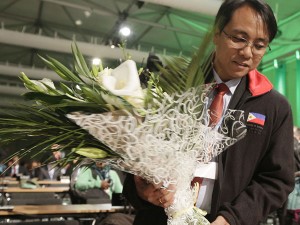MANILA, Philippines — Climate Change Commissioner Naderev “Yeb” Saño, who captured the world’s attention by giving a tearful speech at a United Nations conference on global warming, now believes the Philippines can no longer afford to wait for the rest of the world to take action.
He said it was time for the Philippines to take matters into its own hands in responding to extreme weather events arising from climate change – by rebuilding “safe, prosperous and resilient communities” through a comprehensive land use policy.
Saño, along with other advocates, pushed on Wednesday for the passage of a law setting guidelines for a nationwide land use plan that would clearly categorize areas, without exception, into four types: protection, production, settlements and infrastructure.
At a press conference in Quezon City, he said the devastation of supertyphoon “Yolanda” (Haiyan) magnified the necessity of such a policy.
“The farther we go away from Yolanda, the nearer we get to the next one,” Saño said.
In his November 11 speech, at the Warsaw climate talks, Saño blamed global warming for the “staggering” devastation caused by Yolanda in the Philippines.
“What my country is going through as a result of this extreme climate event is madness, the climate crisis is madness. We can stop this madness right here in Warsaw,” Saño said, choking back tears as he recounted how he had just gotten word that his family in Tacloban City, was safe after the storm.
His tears moved some delegates to stand up and applaud. They also set the mood for the start of negotiations for a new treaty that would work out a mechanism to raise a $100-billion loss-and-damage fund to compensate countries like the Philippines that usually bear the brunt of extreme weather conditions.
But the negotiations stalled after rich nations refused to engage, prompting a walkout of the Group of 77 plus China bloc of developing countries, including the Philippines.
At the press conference, Saño said the time for debating was past, and the country must no longer wait for the world to do anything.
Considering that most vulnerability indices have placed the Philippines among the top three countries most heavily affected by climate change, it must strive to remove itself from “the vicious cycle of disaster after disaster,” and to formulate a national physical planning framework that would protect communities from calamities, he said.
Under the proposed National Land Use Act, the progress of which has stalled since the eighth Congress, critical watersheds and forests shall be delineated for protection, preservation and rehabilitation.
It also prohibits activities in critical areas that reduce river habitats and alter flood patterns, such as large-scale irrigation and river channeling.
Dinagat Representative Arlene “Kaka” Bag-ao said the land use plans in most municipalities tended to be “whimsical,” meaning the local governments would “adjust” them to accommodate commercial interests.
She cited as an example a hypothetical developer seeking to construct a subdivision on a mountain slope because of the great view. “What the local government will do is just to adjust their existing land use plan to accommodate the subdivision,” she said.
“Focusing on disaster preparedness is a quick fix and comes from the wrong premise that every natural phenomenon would necessarily result in a disaster, with people dying, infrastructure damaged, and crops destroyed,” Bag-ao said.
A survivor of Yolanda, Rico Cajife of the People’s Initiative toward Peace and Sustainable Development also spoke at the press conference, saying he considered Yolanda to be a “great equalizer” in that it did not discriminate between the rich and the poor.
He said he hoped that the devastation from the storm would spur legislators into finally passing the land use law, and lay to rest any opposition arising from vested interests.
RELATED STORIES:
Superior berates ‘crying’ climate exec Saño
Philippine envoy cheered in UN climate talks
